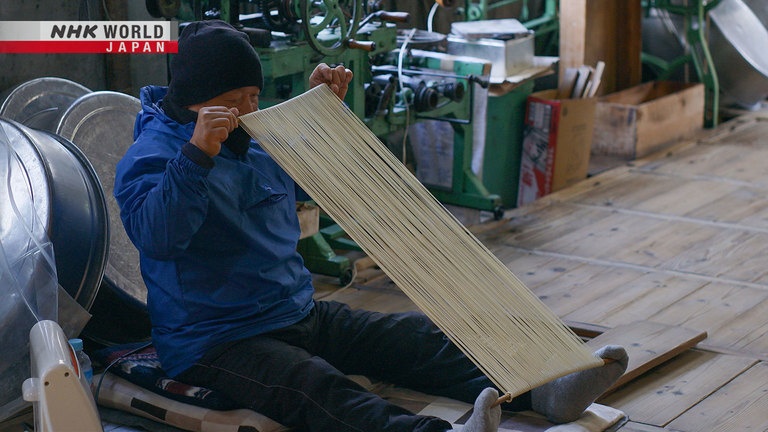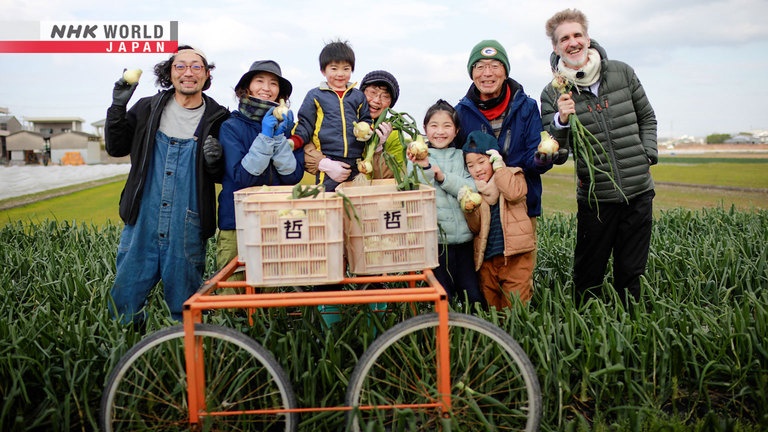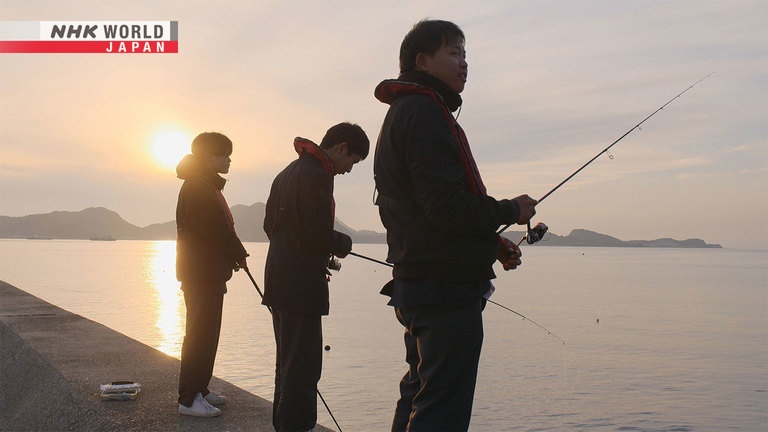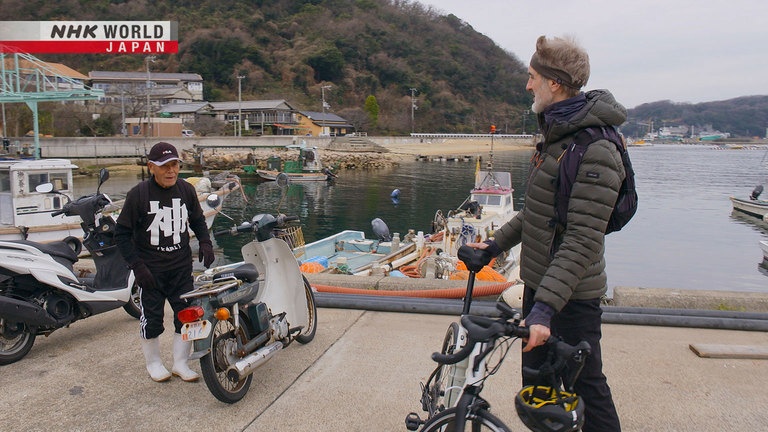Awajishima and Ieshima - An Island Journey
On Awajishima and Ieshima in the Seto Inland Sea, islanders utilize the strong winter winds and waves to enhance local specialties like sweet onions, handmade noodles, incense sticks and seaweed.




Transcript
The best way to discover little-known sights
and make even familiar places feel brand new,
is to go exploring by bicycle.
This time we're exploring the islands of Awajishima and Ieshima, in the west of Japan.
We'll be discovering how the islanders make best use of the winter season.
Nicely done!
Our cyclist is Florent Dabadie.
I'm all alone in this "matsu-no-ki" forest.
As a poet would say, just listen to the silence.
On these small islands, so blessed by nature,
everyone we met has an incredibly positive attitude to life.
Whether young or old, they all firmly believe in the future of their beautiful islands.
Nothing's more important to me than this place.
Come with us now, to the islands of Awajishima and Ieshima.
We've flown about 500 kilometers west from Tokyo to the city of Akashi, in Hyōgo.
Just across the strait we can see our first destination, Awajishima.
Bonjour! Good morning! What a gorgeous weather.
But what you can't feel is the cold.
It's amazingly cold today.
But that's why we have a clear sky.
So the adventure begins.
Florent Dabadie is from France.
In 1998, an interest in Asian languages led him to Japan.
Florent's many jobs have included interpreter for the Japanese national soccer team and TV sportscaster.
All right!
Taking just 13 minutes, the ferry is the best way to get to Awajishima, as you can just take your cycle onboard.
There's the front, the Japan that you have in the big cities.
And then there's the other Japan, which is much more slower.
And for me, this Japanese spirit is embodied by the island spirit.
It's the small islands where you find this other Japan.
Here we go. Island.
Florent will start the trip by riding right around Awajishima.
The first day takes him down the east coast to Fukura, and on the second, he'll ride back up the west coast.
In all, a 150-kilometer ride.
Welcome to Awajishima. Morning cycling! Ah, let's go!
Look at that sky!
January temperatures in Awajishima average a high of 11 degrees Celsius.
That feels a bit chilly, but rainy days are rare, making it great weather for cycling.
45 kilometers from the start, we're on a complex and fascinating section of the coast.
Nice weather. Good sun. Wonderful view.
It's starting to be fun.
This section, with inclines of up to 19 degrees, is a favorite with cyclists.
- Hello! Nice bike.
- Thanks.
The big downhill.
Wow. The west light is mesmerizing.
Ah, the sun! Yes, the sun!
Oh, that's a cycling paradise.
80 kilometers riding has brought Florent to the fishing port of Fukura.
The streets are getting kind of narrow.
In the boom years of Fukura's fishing industry, people built homes on every available scrap of land.
I can hear some kind of manufacturing noise here.
Everywhere you look are small factories making sōmen, a very popular type of thin wheat noodles.
Florent decides to check out a sōmen factory.
- May I come in?
- Sure!
I was wondering about all the factories.
Can I watch you work?
Fukura began producing sōmen about 180 years ago.
Ōta Hiromu is the third generation of his family to make these noodles.
This was originally a side job for fishermen during the winter when the sea was too rough to fish.
After they've rested in the warmth down there,
we pull and stretch them many times.
Doing it like this keeps them flexible and strong,
so they won't break as they get longer.
Charmed by Florent's enthusiasm, Ōta insists he tries his hand at pulling the noodles.
Your legs are too long!
Try one at a time.
It's like rubber.
Pull and it'll stretch.
It gets so long without snapping!
That's because we let it rest each time.
You never use the fingers of your feet.
That's a good exercise.
The craftsman's skill lies in pulling the noodles according to their condition,
which changes depending on the day's temperature and humidity.
Pulling the noodles by hand like this makes
them extra tasty and chewy.
The next stage is to use special chopsticks to separate and further stretch the noodles.
Everything is done by hand, and it's very time-consuming.
My father used to tell me noodles are alive,
so care for them like you care for your wife.
It's hard being the wife of a noodle maker.
But this work needs two of us to do properly.
It's much tougher for her.
On top of this work, she does all our cooking
and looks after the house.
That's been her life for almost 50 years now.
The couple met in Osaka.
After university, Ōta had a career there as a salesman in the apparel industry.
But he gradually became dissatisfied with that line of work.
I got tired of working for other people,
and wondered how well I could do on my own.
I chose somen because I wanted to hear people say
"Only Ota could make noodles this tasty."
At its peak, Fukura had 130 sōmen factories.
However, the industry mechanized, small factories couldn't compete, and now there are only 12 left.
Ōta still makes hand-pulled noodles, believing their taste is unmatched.
That's beautiful. Like ship sails.
The finest sōmen noodles require 25 hours work to produce.
I hope you'll like this.
In winter, sōmen are best eaten hot, in a dish called nyūmen.
I guess it's the way they make it so it has elasticity. And it has some sweetness.
They're absolutely delicious.
Florent starts the second day riding across the Mihara Plain in the south of Awajishima.
There are many crops in the inland.
Wow, beautiful lettuce.
Look, it's huge! Huge lettuce.
This is also...Those look more like root veggies.
Even in winter, this area continues producing crops, notably lettuce and Chinese cabbage.
Awajishima's most important crop is onions.
I don't know if I can actually ask him.
Hello!
Are these onions you're growing?
Yes. These are an Awajishima specialty.
I'm just about to start harvesting them.
Hamada Tetsuji's family have been farming here for 80 years.
Awajishima onions are tender and not pungent.
The sea breeze brings minerals to the soil,
making them sweeter than regular onions.
Florent lends a hand with the harvesting.
Look at that! It's huge!
Ah, superb.
It's so sweet!
And juicy too!
Our family eats onions three times a day, every day.
These are delicious, cooked or raw.
Onions are normally harvested in spring on Awajishima,
but Hamada grows 10 varieties, each suited to a different season, so he gets crops throughout the year.
On weekends, the whole family comes to help with the harvest.
This is my son, Kenji, and his wife Eri.
Their children Takeru, Ryo and Aoi.
And my wife, Atsuko.
A family of seven.
Who likes onions?
- How do you like to eat them?
- Mixed with rice.
How about Aoi?
Grilled like steak.
Hamada originally worked in local government, only farming in his spare time.
This changed when he was 52.
He quit his job to care for his aging mother and run the family farm.
That's when he decided to focus on growing onions.
It's like starting new every year.
Everything about this is trial and error.
It doesn't matter whether I fail or succeed,
I have no regrets. This is my life.
He's always on the go,
working from 3am till late every night.
I want to learn how to become like him.
Farmers around here are aging and have no successors willing to work their fields.
Hamada has been taking over these farms and gradually transforming them for onion cultivation.
12 years ago, he also started offering a pick-your-own onions experience,
which now attracts 2,000 visitors a year.
He's constantly finding fresh ways to promote the island's onions.
He's always coming up with new ideas,
and trying them out.
I think it's wonderful, but sometimes
it's hard for us all to keep up with him.
I'll keep working like this while I still have my health,
and the family is a great help.
He's always an inspiration.
Hamada's onion business keeps on growing, just like his family.
This part of the coast is all forested with pine trees - over 50,000 of them.
Under the trees, Florent sinks into a contemplative mood.
I'm all alone in this "matsu-no-ki" forest.
As a poet would say, just listen to the silence.
Florent is now riding north up the island's west coast.
It's very beautiful. But the wind is terrible.
The winter wind is strong, but it's given Florent a fresh burst of energy.
No cars! If it wasn't for the wind, it would be just incredible.
Look - I'm alone. Look at the nature! Hey bird!
130 kilometers from his start, Florent is now in the town of Ei.
Wow! The scent! It's very powdery, kind of musk.
Wow, it's quite strong.
Ah, that's nice.
Drawn by the fragrance wafting through the streets, Florent has found a perfume store.
The perfume! The scent is marvelous.
This perfume shop was founded over 100 years ago.
The Japanese typically burn these incense sticks, known as senkō, in memory of the deceased.
Hello!
Nice to meet you.
Welcome.
This is the owner, Yano Takayuki.
Yano is a specialist in blending incense fragrances.
He's producing new kinds of senkō with the goal of expanding the uses for this incense.
Yano believes it could make an ideal room fragrance too.
Awajishima is Japan's major producer of senkō, making over half the sticks sold nationwide.
Ei was once a prosperous sea trading port.
The sailors made incense as a side job in winter, when the seas are too rough to navigate.
Looks like a pasta factory.
The exact recipe is a closely guarded family secret, passed down from generation to generation.
Excuse me, how long have you been doing this?
40 years! That's amazing.
Every day we light an incense stick on
our household Buddhist altar.
Incense and a prayer calms the spirit.
The incense called "wabisabi" contains medicinal herbs that give it a somewhat bitter aroma.
Wabisabi has a bracing fragrance.
It sort of whips you into shape.
Yes, I feel ready to take on the world.
The name of this one means
"compassionate amacha incense."
If you're worn out or tense,
this will relax and calm you down.
Yano is especially proud of this incense.
It's made with amacha, a hydrangea tea offered to the gods at Buddhist festivals.
This one also is really amazing. It's so sweet.
It's almost like a cake.
I have lots of images of my childhood coming back right now.
The wind that constantly blows through this town is fundamental to its incense industry.
For 10 days, the incense is dried slowly and naturally by the wind, locking in the fragrance.
We get westerly winds here all year round,
which is ideal for drying the incense sticks.
See how strong the wind is.
Feels good though.
This style of sliding window is called bekako.
Invented generations ago, it remains a highly functional part of the incense making process.
I was born in a town of incense makers,
so I guess it was my destiny to do this work.
I'm always trying to improve our products,
and make them better for people to use.
Florent has now ridden almost all the way around the island.
It looks like the rain is coming. Look!
Just perfect timing.
Ah, the bridge. Here's the Akashi Bridge.
The Tour of Awaji. I mean, that was fantastic. I loved it.
It's kind of a dramatic ending.
And I think that pretty soon, looking at the crazy haze that I have behind me, there's going to be a storm here.
So, see you next time.
Today, Florent is heading for Ieshima.
30 minutes by ferry from the mainland, this is a small island, just 15 kilometers around.
We've arrived at Maura Port.
Here we are.
The calm waters of Ieshima's bay, protected from the rough seas,
made the island a center of shipbuilding and the sea trade.
The large ships at anchor in the harbor transport stone from the surrounding islands.
The island's population was once over 7,500, but today that number has fallen to 2,100.
It's a really small island.
The density of the little population here.
Believe it or not, this is the main street.
There's so little flat land on the island, houses were crammed into every space available.
Wow, that fish looks tasty.
A bookshop!
Florent has found the island's only bookstore.
Oh, let's take a look — come in!
It doesn't just stock books - it has many toys and products aimed at children.
Snorkeling gear.
That's for kids too.
I used to sell just books and stationery,
but as the population fell that wasn't enough.
So I added children's books, toys and snacks.
We also supply school textbooks.
Been doing that for about 80 years now.
After the bookshop, Florent heads to the town's high school.
He's heard that some of its students engage in a unique after-school activity.
Ah, it's a highschool.
Hello!
Why are you carrying all that stuff?
We're going fishing.
- That's your hobby?
- It's a school activity.
- What's it called?
- Gyobu. The fishing club.
Although fishing is their main activity, the club also engages in nature study and even cookery.
This school has a unique curriculum, with many classes focused on the sea.
For example, students can take classes aimed at acquiring a captain's license,
and there are also marine-based sports.
This is where we fish.
It looks like they want me to join.
I've never done any fishing in my life.
It's probably the furthest thing from my lifestyle.
Everything has a first time.
Hold it with your middle and ring fingers.
Move the rod up and down to attract the fish.
- Do you think we'll catch any?
- You never know.
What's the biggest you've ever caught?
A 30 cm scorpionfish.
- I made it into sashimi.
- Oh, you can prepare fish yourself?
Recently I'm getting OK at it.
I catch loads of fish, so I can practice a lot.
What about you?
My biggest was a scorpionfish too,
but only about 20 cm.
We fried that one.
None of the club's nine members live on this island - they all come to school by boat.
I live on that island over there.
It's called Boze.
Bōzejima has always been famous for its fishing industry.
My father went to this school.
And you're following in his footsteps?
Yes, I plan to become a fisherman too.
Fukumoto lives on the mainland.
He chose to come to this island school because he's loved the sea since he was a child.
What's Ieshima like?
It's a peaceful place.
People here are very warm and friendly.
One even jokingly offered to give me a house.
What do you want to do after school?
I plan to become a ship's officer.
I used to listen to the old men
in the harbor telling tales about the sea.
That's where my dream started.
In the cold winter water, the fish tend to become inactive.
Everyone's having a hard time today.
Oh no.
That doesn't look good.
I don't suppose we can eat this?
You could try. Haha.
Two hours later, and still nothing.
I think time's up.
How was today?
Pretty bad luck.
How will your father feel
when you don't bring home any fish?
No problem.
We have plenty of fish at home.
You'll be OK then.
Thanks for today. Take care!
A small island, drawing youth in pursuit of their dreams.
On the morning of his final day, Florent sets off to tour the island.
I see cats!
Oh, one, two, three.
Hello!
Ah, they seem pretty well-fed, probably with the fresh fish.
Today, Florent has arranged to meet an island fisherman.
I think that must be the place.
- Hello! Nakamura san?
- Yes.
Nice to meet you.
At age 83, Nakamura Shōsuke is still an active fisherman.
Winter is the main time for harvesting nori seaweed.
This is my son, Yusaku.
Hello!
Made strong by the waves buffeting the coast of Ieshima,
this nori is top quality with a pleasing texture.
It's so soft. Wow.
It already does look delicious.
No problem. I don't need any sauce, any manufacture.
Nakamura has been producing nori for 50 years.
The fisherman's life is uncertain and doesn't guarantee a stable income,
so Nakamura started seaweed farming too.
With his family working shifts to operate the factory around the clock,
he produces 100,000 sheets of nori a day.
Other islanders followed Nakamura, building their own seaweed factories, and nori became an Ieshima specialty.
This is my wife.
She's always been a great help.
Don't film me, I'm shy of cameras.
She looks after the money side of things.
He loves new things.
He's always the first to try anything new.
A pioneer.
Nakamura left school at the age of 15 and has been a fisherman ever since.
But this is a man not willing to restrict himself to one or even two occupations.
He's taking Florent to Tangajima, 10 minutes by boat from Ieshima.
Nakamura also runs a guest house on this island.
Look! That is it! Nakamura-so.
So that's Mr. Nakamura's youth hostel.
I invest my profits from seaweed in this.
It's big!
Nakamura started the guest house to attract tourists and revive the economy of the island.
As well as fishing, the guest house offers visitors many ways to enjoy the island environment,
and repeat guests have continually increased since it opened 50 years ago.
In summer the island now welcomes up to 200 visitors a day.
It would be simpler to just sell fish, but this way
I can help visitors enjoy the island more.
Don't you ever take a day off?
No. 365 days a year.
No breaks.
Following Nakamura's lead, others are helping develop this island.
Last year, a regular visitor to his guest house opened this new cafe.
Nakamura san is always such fun,
and he's so dependable.
We have the same goal - making our island
a more vibrant place.
Running the guest house lets me meet new people.
It's a great feeling to hear guests say
"We'll definitely be back next year!"
So what does this place mean to you?
After life itself, nothing's more important.
Florent has returned to Ieshima, and is seeking higher ground to enjoy a final sunset.
The sun rays. Wow.
How peaceful, isn't it?
The sunset.
And the quietness.
Awajishima and Ieshima people is - when they set their minds on something, nothing can stop them.
They all first believe in the potential of the island.
They know that it has a strong potential for the future, and they could convince their families of course.
There might have been some fear, but more than that,
they knew that if they make it right, if they work hard, the island will give it back to them.
What I felt during my stay here in Ieshima and Awajishima,
is on the contrary, people here kind of encourage you to go for it, to push your limits.
Regarding the people, I think they had a special mentality.
There are so many to discover.
That was really lovely.
Two islands with amazing potential, and islanders with a firm belief in their future.